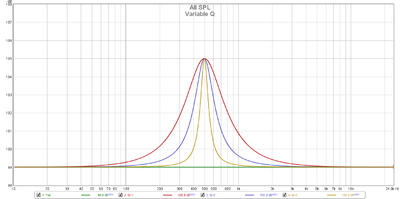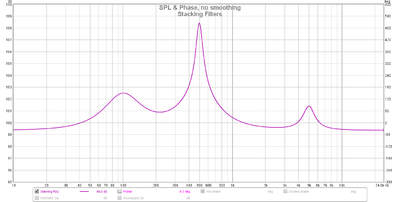Parametric Equalizer
Overview
Media Center's DSP Studio includes a powerful and flexible parametric equalizer (PEQ) that can be configured with any number of filters. PEQ can be used for simple tasks like equalization and channel routing as well as advanced tasks such as creating a crossover for active speakers, performing bass management and applying a compressor.
This page provides an explanation of how each option works as well as some guidance on typical uses.
Verifying Your DSP Studio Configuration
See Verifying DSP Studio for details of how to measure your configuration.
All graphs in this section were created using the method described in that page.
Use Cases
| Use Case | Description | Link |
|---|---|---|
| Custom Mixing | Allows the user to perform their own custom mixing, e.g. for bass management | Mixing |
Adjust a Frequency
This option creates a "Peaking EQ" filter, such a filter may also be known as:
- a parametric EQ filter
- a notch filter
Such a filter provides a cut or boost which is centred on the specified centre frequency
4 values must be entered by the user:
- Frequency: the centre frequency of the filter
- Bandwidth (Q): specifies the frequency range over which the filter will boost or cut, the higher the Q, the narrower the range over which the filter operates
- Gain: the maximum boost or cut applied by the filter, i.e. the boost or cut applied at the centre frequency
- Channels: the channels to apply the filter to
What type of peaking filter is used?
MC implements a type of filter known as an RBJ filter after the author Robert Bristow-Johnson who published the EQ Cookbook - http://www.musicdsp.org/files/Audio-EQ-Cookbook.txt . This type of filter is also known as a proportional Q filter in rePhase
Understanding Q
Q is defined relative to the centre frequency of the filter, it is the centre frequency divided by the bandwidth of the filter where the bandwidth is defined by the +/-3dB points.
For example, if the centre frequency is 500Hz and the -3dB points are at 450 and 550Hz then we have a bandwidth of 100Hz. Therefore Q = 500/100 = 5
Another example, if the centre frequency is 100Hz but we maintain the same 100Hz bandwidth then Q = 100 / 100 = 1
Examples
Varying Q
This example shows a series of filters centred at 500Hz with Q of 1, 2 and 5 and a +6dB gain
Stacking Filters
Filters can be stacked to produce complex shapes
High-Shelf
Allows you to boost or cut all frequencies that are higher than a certain frequency. The boost or cut will increase as the frequency increases at different rates depending on the Q (higher is steeper, lower is more gradual). The gain setting is how much total boost (or cut) there will be at the top (or bottom) of the shelf. The frequency is the exact middle of the shelf's rise or fall. The channel setting lets you specify which channels are affected. A Low-Shelf is the opposite of a High-shelf, it boosts or cuts all frequencies below a certain frequency. Here's a picture illustrating the response of two different shelving filters http://en.wikipedia.org/wiki/File:Shelving-eq.svg. I don't know the exact parameters they used to create those examples, but the red trace in the illustration is probably a -3dB low shelf set at 150Hz with a Q of .5.
High Pass Filter
Attenuates all frequencies below the set frequency by a continuously increasing amount (as frequency decreases). The slope is the steepness of that attenuation (6dB per octave, 12 dB per octave, etc.). A Low Pass Filter is the exact opposite, it attenuates all frequencies above the set frequency. Here's an illustration of five different butterworth low-pass filters with different slopes (6dB, 12dB, 18dB, 24dB, 30dB) http://en.wikipedia.org/wiki/File:Butterworth_Filter_Orders.svg. The 6dB, 12dB, and 24dB filters in Jriver should look exactly like the illustrated ones (1,2, and 4). Correct use of low pass and high pass filters is kind of complicated, but they are typically used to create speaker crossovers, for protection of vented (ported) loudspeakers, or to interface a subwoofer with existing speakers.
Adjust Volume
Lets you adjust the volume (up or down) of an entire channel by the amount set in the Gain parameter. This is useful if you, for example, have multiple speakers of different varieties in a surround setup and you need to level match them; the Room Correction DSP module also has level matching tools.
Delay
Lets you delay channels so that they output later than other channels. This is useful if you have multiple speakers that are different distances from you, or if you're using an active crossover. I'd recommend against setting delay in Parametric Equalizer unless you have a measuring microphone handy. The Room Correction DSP module also has tools to help address speakers that are different distances from you, and might be easier to use (without a mic) if you just need distance adjustment.
Reverse Polarity
Reverses the absolute polarity of the selected channel(s). This is useful if your speakers are wired backwards, if you're using an active crossover, or for better subwoofer integration in some room setups. The Room Correction DSP module also has an option to reverse polarity on a speaker by speaker basis. More info about what "polarity" means in this context here: http://en.wikipedia.org/wiki/Absolute_phase#Sound_reproduction
Linkwitz Transform
A filter that boosts low bass performance of a speaker. It is not typically a good idea to use a Linkwitz transform with vented speakers (speakers with ports in them), and isn't necessarily a good idea with sealed speakers (depending on your speakers and the settings you choose). It's generally a more "advanced topic." Here's a very good article on what it does with illustrations: http://sound.westhost.com/linkwitz-transform.htm
Limiters
Prevents sounds that are louder than the limit from playing on the selected channels. They're essentially a method of protecting your speakers if you're concerned that they might get a damagingly loud signal sent to them. This can usually be achieved in other, simpler ways (like turning down the volume on your amp), but there are circumstances where PEQ is the best place to handle that kind of thing.

